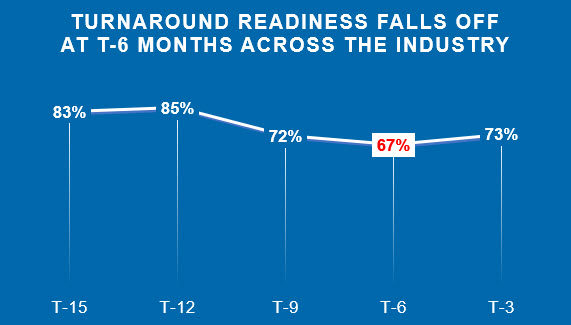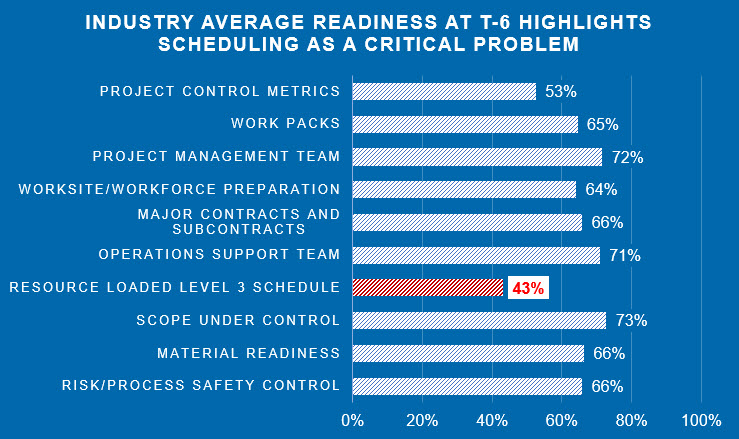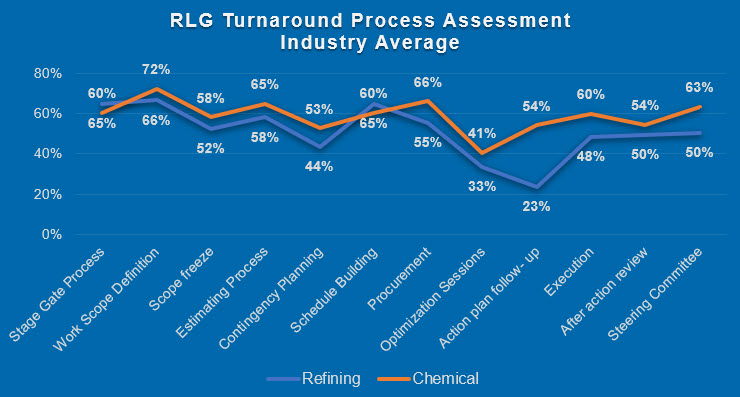Cezary Goch
Maintenance turnarounds in operating facilities play a major part of the overall asset strategy. Across industries, the planning and execution of major shutdown and turnaround events can stress even the largest organizations due to complex interdependencies between the many stakeholders, ranging from Operations to Maintenance, Supply Chain, and numerous contractor agencies. Scope gathering needs to be balanced with timelines and cost, and planning needs to be comprehensive, complete, and timely.
With all this complexity, how can one ensure that preparations, also known as Front-End Loading (FEL), are proceeding on target, from nearly two years before the event right up to pre-execution?
Leading organizations undertake audits or assessments of their Turnaround Process and Event Readiness using one of three approaches, or some hybrid between.
Three approaches to Turnaround Readiness Reviews
1. Internal Peer Review using a Site Team
The first approach of Internal Peer Review using a site team involves formally assigning a small internal multidisciplinary team to undertake a review of process or readiness. This type of review typically exists in smaller organizations where corporate resources are not available, or in some mid-size organizations where geographic or corporate silos prevent a cooperative approach across sites. The designated team of auditors work ad-hoc or on a pre-determined schedule to review documents, interview turnaround team members and attend meetings to observe team interaction and planning progress. Often, the Steering Committee takes that role.
This approach offers a few advantages over other approaches:
- A lower cost and often a lesser scope of the assessment mean reduced interference to the turnaround planning team and activity.
- Trust and rapport for the internal team is typically higher
- Familiarity with the equipment, process and systems is high, so efficiency can be maximized
Cons:
- Generally, a lower level of scrutiny and challenge combined with biases in the assessment team usually result in overly optimistic assessments and failure to spot emerging risks.
- A lack of outside perspective results in missed opportunities to adopt corporate and industry leading practices, standards, and behaviors
- Due to familiarity with members of the assessment team, conclusions and recommendations from the assessment team may not be taken seriously and enacted within the turnaround organization.
Turnarounds are a huge risk to your organization. With millions of dollars of investment in materials and worker-hours, and production at a standstill, every shutdown day needs to be executed with precision.
2. Internal Peer Review using a Corporate Team
The second approach of Internal Peer Reviews typically take place in larger organizations that have a few plants under their umbrella, often with a central technical team tasked with a supporting role. Employees from the central team, and/or other plants, visit the facility under review on an ad-hoc or pre-determined schedule and spend a few days reviewing state of preparation to execute. Members of the peer review team will interview staff of the turnaround planning team, review samples of plan documents, and hold meetings to discuss progress, planning and challenges. This may or may not follow a prescriptive audit template.
This approach offers several advantages over the internal-only team:
- Increases likeliness of using a consistent, corporate methodology.
- Insiders from the same company may have more trust and immediate rapport than outsiders.
- Allows for broader use of company-wide lessons learned from past events while promoting discovery of new best practices for wider corporate adoption.
- The outside viewpoint is typically more credible and taken more seriously than an audit by internal-only auditors.
- Familiarity knowledge of internal processes and equipment will aid efficiency and will help auditors appreciate specific scope and challenges.
Cons:
- Turnaround process and readiness are mostly internal comparisons of one site against another, or one event versus the last, without a broader perspective of this event and team versus the practices of leading organizations.
- It lacks a broader view of industry best practice and approaches.
- It often misses human aspects of preparations (such as communication, meetings quality and information flow).
- Many imperfections are dismissed as the natural or normal within their corporate environment, often despite this being a deviance from industry best practice.
3. Consultant as the Assessors
The third approach to audits or assessments of Turnaround Process and Event Readiness is to use an external auditing agency. Our experience is that few consultants provide such audits in a repeatable, consistent way. Beyond the internal assessments already described, including an external agency allows for a wider perspective and deeper understanding gained from working both within and across industries. With exposure to a broad range of clients, the consultant in partnership with the turnaround planning team can evaluate turnaround process and event readiness to wider process, practice, and preparation data set.
This offers several advantages:
- Benchmarking against performance databases collected over periods of time and from a variety of companies and facilities
- Feedback and recommendations against best practices in the industry
- Higher efficiency due to experience and skill in conducting assessments using standardized tools and processes
- A less subjective feedback, with an ability to tell how it is while not being subjected to internal political systems and bias.
An outside consultant typically provides a much broader spectrum of findings and advice – a mix of technical, system, process, and soft skills.
Cons:
- Lower early rapport amongst the team until relationships develop. Spending time early to build relationships opens the door to more information and idea sharing.
- Failure to appreciate nuances of site and circumstance, resulting in incomplete interpretations of meaning
- Less familiarity with site equipment, staff members, contracting strategies and history means more time spent to understand local conditions, culture, and practices – if not, there is a danger to blind-compare to best practices • Greater dependency on site resources to source data, documents, and schedule meetings
Internal assessments capture the low hanging opportunities, while external assessments allow a rigorous process with best practice from across multiple industries.
Recommended Practice
Leading organizations take a blended approach. Internal Peer Reviews, also known as Peer Audits, introduce accountability to the turnaround planning team and identify major gaps while cleaning up low hanging opportunities. Outside consultant reviews are more rigorous and when coupled with a commitment for improvement, lead to significant risk mitigation and performance improvement. As for timing, external consultant agencies are usually enlisted within the 18-month planning interval leading up to a major turnaround event. To shine a light on new and different elements and introduce new thinking, some organizations switch-up the team or consultant from time to time.
Looking at assessments conducted in refineries and chemical plants in North America and western Europe, a trend is emerging. At 15 to 12 months before execution, turnaround planning teams tend to follow protocols and preparation quality remains high – above 80%. (with 100% being perfect follow-up on both process and deliverables).
At T-9, when scope freeze, work packs, and schedule become the focus, we see declining preparation readiness, with a consistent low point at T-6 months before turnaround execution. This is often where under-resourcing and procedural gaps are most pronounced, with a optimistic “we can catch up” chorus across the organization.

Looking closer at the categories of readiness at T-6, we see the Resource Loaded Level 3 Schedule as the greatest deficit. This is not surprising and is most often the consequence of many slipping deadlines and a weak scope freeze leaking changes and uncertainty into contracting, materials, work packs and scheduling activity.

Introducing periodic readiness assessments helps in a big way, especially when done from T-12 months or earlier, and even more when accompanied with a commitment to close identified gaps.
Alignment Exercise
Another powerful tool often introduced alongside readiness assessments is the “Alignment Exercise.” This acknowledges that the quality and completeness of Front-End Loading (FEL) in turnaround planning depends heavily on the entire company being aligned around the turnaround event, the turnaround group and their preparation and commitment to deliver on targets. Too often we see the turnaround as an activity, not an important event, and the planning team struggles to get the resourcing, attention, and cooperation they need to deliver safely on time, on budget and with quality.
The Site Leader should lead a “Alignment Exercise” – or similarly named review of the TAR preparation efforts. This is a best practice emerging within “Best in Class” Refineries and Chemical plants. It involves a structured and facilitated discussion including the key players involved in preparing the TAR (Typically upwards of 20+ people). In the session, the Site Leader along with their Leadership Team is testing and challenging:
- The messaging effectiveness and widespread buy-in to the event’s success.
- The quality of the integration across functions.
- Individual discipline preparedness.
- Overall understanding of risks and contingencies.
- Understanding and actioning issues that remain unresolved.
- Checking progress of delivering pre-work milestones.
- Looking for evidence of teamwork, coordination, and systems to support it.
- Looking for a clear and coherent plan for how the organization will meet, share information, and make decisions during the actual event.
- Paying careful attention to who is in charge, who runs meeting and what the objectives are. Intervene to limit the number of meetings and maximize the amount of time that people are solving problems and running the TAR versus being caught up in long, unproductive meetings.
- Lower early rapport amongst the team until relationships develop. Spending time early to build relationships opens the door to more information and idea sharing.
- Failure to appreciate nuances of site and circumstance, resulting in incomplete interpretations of meaning
- Less familiarity with site equipment, staff members, contracting strategies and history means more time spent to understand local conditions, culture, and practices – if not, there is a danger to blind-compare to best practices
- Greater dependency on site resources to source data, documents, and schedule meetings
If the organization is not able to deliver against the pre-work milestones, they most likely will miss the execution milestones as well. If alignment is an obstacle from the start, problems will only amplify as time progresses and pressure builds. The pre-work interval is the time to establish expectations for delivery and develop skills and procedures for rapid problem solving. At T-12, T-9, T-6 and T-3, the Alignment Exercise will test and help keep a closeness amongst various stakeholders – often a varying set at each interval.
Turnaround Process Assessment
Before concluding, this article would be incomplete without mentioning the importance of Turnaround Process Assessments. In contrast to Readiness Assessments which look at whether the planning has progressed in quality and quantity to where it should be at a point in time, Process Assessments look at the culture of the turnaround organization – that is, the way things are “done around here.” The Process Assessment studies capability and practice in planning processes, skills, templates, procedures, and adherence to written protocols. It considers contracting and materials strategy, and pinpoints areas where changes are needed to minimize risk and deliver a turnaround event that meets targets of safety, duration, cost, and quality.
While every business is different in their size and complexity, we often find three things in our Turnaround Process Assessments:
- Procedures are written but not followed, sometimes due to gaps in training and awareness, and sometimes due to a lackadaisical culture.
- Scope and work packs are compiled, and schedules are built as a check-the-box exercise without optimization.
- Meetings are run too casually and without rigorous attention to action tracking and action follow-up accountability.

Conclusion
Turnaround Readiness Assessments should be an integral part of turnaround planning, especially for major events. Leading organizations write these assessments into their stage gate planning process and engage a hybrid of internal and external teams to conduct the assessments. Readiness checking at T-9 and T-6 months are the most meaningful with adequate timeline for course-correction. There needs to be commitment to closing identified performance gaps. Consider sessions to test and create alignment across the organization in support of the turnaround event to build a shared ambition for good results in safety, duration, cost, and quality. For a more comprehensive look at your turnaround culture, conduct a Turnaround Process Assessment.
With these in place, the business can expect:
- Increased personal and process safety.
- Lower risk in work plans, schedule errors, coordination gaps, and unexpected scope addition or change.
- Lower cost in expediting and fewer overall workers.
- Smooth transitions from planning, to pre-execution and into execution.
- Higher workforce productivity, with better plans, clear procedures and aligned execution.
With questions or for more information how RLG’s approach to readiness and process reviews, and turnaround performance coaching, might fit your organization, reach out to YXNrQHJsZ2ludGVybmF0aW9uYWwuY29t or contact us by phone. You can view case studies of our work in turnarounds here.
Slipping deadlines and a weak scope freeze leaking changes and uncertainty into contracting, materials, work packs and scheduling activity puts the entire turnaround execution at risk. Leading organizations use Turnaround Readiness and Process Assessments to identify and close gaps early.